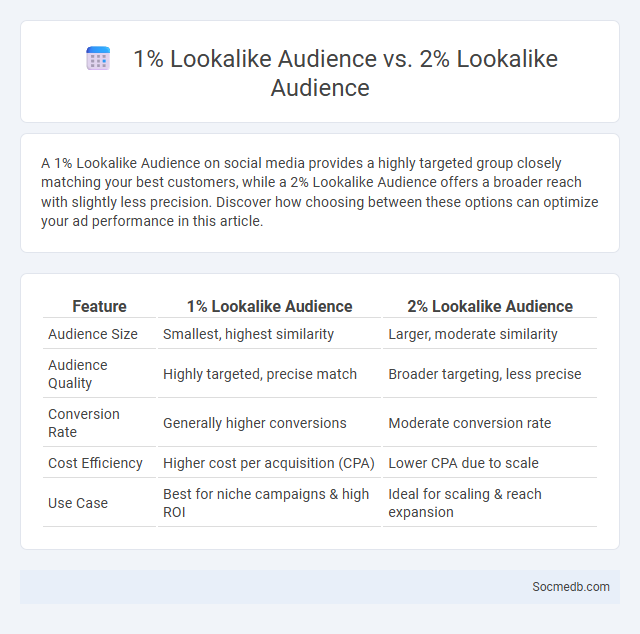
Photo illustration: 1% Lookalike Audience vs 2% Lookalike Audience
A 1% Lookalike Audience on social media provides a highly targeted group closely matching your best customers, while a 2% Lookalike Audience offers a broader reach with slightly less precision. Discover how choosing between these options can optimize your ad performance in this article.
Table of Comparison
| Feature | 1% Lookalike Audience | 2% Lookalike Audience |
|---|---|---|
| Audience Size | Smallest, highest similarity | Larger, moderate similarity |
| Audience Quality | Highly targeted, precise match | Broader targeting, less precise |
| Conversion Rate | Generally higher conversions | Moderate conversion rate |
| Cost Efficiency | Higher cost per acquisition (CPA) | Lower CPA due to scale |
| Use Case | Best for niche campaigns & high ROI | Ideal for scaling & reach expansion |
What Is a Lookalike Audience?
A Lookalike Audience is a powerful social media marketing tool that helps you reach new users who share similar characteristics with your existing customers or followers. By analyzing data such as demographics, interests, and behaviors, platforms like Facebook create a targeted audience that closely resembles your best-performing segments. Using Lookalike Audiences can significantly increase your campaign's efficiency and improve conversion rates by delivering content to people most likely to engage with your brand.
How Lookalike Audiences Work
Lookalike Audiences use machine learning algorithms to analyze the characteristics and behaviors of your existing customer base, identifying patterns in demographics, interests, and online activity. These insights allow social media platforms like Facebook and Instagram to target new users who closely resemble your best-performing audience segments, increasing the likelihood of engagement and conversion. Leveraging Lookalike Audiences enhances ad efficiency by expanding reach to quality prospects without guesswork, maximizing return on ad spend through precision targeting.
Defining 1% Lookalike Audience
A 1% Lookalike Audience represents a highly targeted group of social media users who closely match the characteristics of your best existing customers, typically selected from the top 1% of a larger source audience. This audience is created by analyzing data points such as demographics, interests, and online behaviors to find users most likely to engage with your brand or convert. Using a 1% Lookalike Audience maximizes the efficiency of your social media campaigns by focusing your ads on people who closely resemble your ideal customer profile.
Defining 2% Lookalike Audience
A 2% Lookalike Audience targets a group of users whose characteristics closely resemble the top 2% of your highest-value customers based on specific data points such as behaviors, demographics, and interests. This audience refinement improves ad relevance and conversion rates by focusing on individuals most likely to engage or purchase based on modeled similarity metrics. Ideal for precision marketing, the 2% threshold balances reach and accuracy to maximize return on ad spend in platforms like Facebook and Instagram.
Key Differences: 1% vs 2% Lookalike Audiences
Targeting 2% Lookalike Audiences on social media often provides broader reach and higher scale compared to 1% Lookalike Audiences, which typically offer more precise match and better conversion rates due to closer similarity to your source audience. Your choice depends on campaign goals: use 1% for highly specific targeting with higher relevance and 2% for expanding brand awareness and potential customer acquisition. Balancing audience similarity and size ensures optimal return on ad spend in social media advertising.
Audience Reach: Size and Scale Comparison
Social media platforms vary significantly in audience reach, with Facebook boasting over 2.9 billion monthly active users, making it the largest network globally. Instagram follows with approximately 2 billion users, while Twitter has around 450 million active accounts, highlighting diverse scale and engagement levels. LinkedIn targets a professional audience with over 900 million users, emphasizing a focused but substantial network size for B2B marketing.
Performance Metrics: 1% vs 2% Lookalike Audiences
Performance metrics for 1% vs 2% Lookalike Audiences reveal distinct impacts on ad efficiency, with 1% audiences typically delivering higher conversion rates due to closer similarity to your seed audience. While 2% Lookalike Audiences offer broader reach and potential for scaling, this often results in lower engagement and increased cost per acquisition. Optimizing your campaigns requires balancing precision targeting against volume to maximize return on ad spend.
When to Use 1% Lookalike Audiences
You should use 1% Lookalike Audiences on social media when targeting highly specific customer segments that closely resemble your best existing customers. This approach increases the likelihood of higher engagement and conversion rates by focusing on users with traits and behaviors almost identical to your original audience. Leveraging 1% Lookalike Audiences is particularly effective for campaigns aiming to maximize return on ad spend (ROAS) and drive quality leads.
When to Use 2% Lookalike Audiences
Using 2% Lookalike Audiences optimizes ad targeting by closely mimicking the top 2% of your highest-value customers, increasing the likelihood of engagement and conversions. This audience size balances reach and precision, ideal for campaigns aiming to scale without sacrificing relevance. Brands typically employ 2% Lookalikes when seeking quality leads or sales while maintaining a degree of audience similarity to proven customers.
Best Practices for Lookalike Audience Targeting
Maximize your campaign performance by creating lookalike audiences based on high-value customer segments to ensure precise targeting and improved conversion rates. Use detailed demographic and behavioral data to refine your source audience, increasing the accuracy of the social media platform's algorithm in finding users similar to your best customers. Regularly update and test your lookalike audiences to adapt to changing market trends and optimize your advertising ROI.
 socmedb.com
socmedb.com